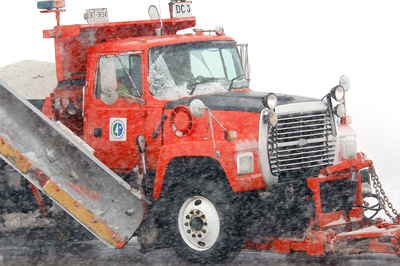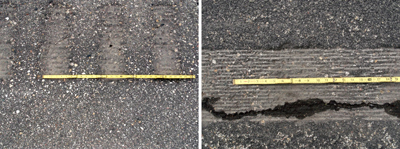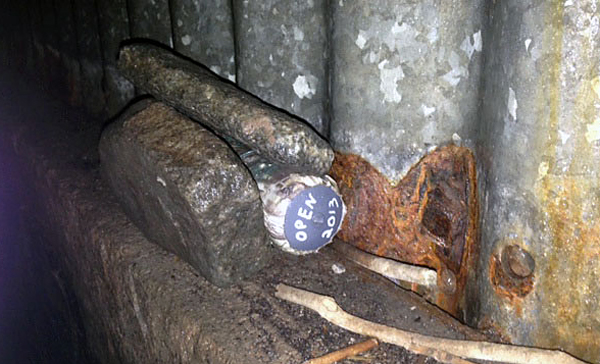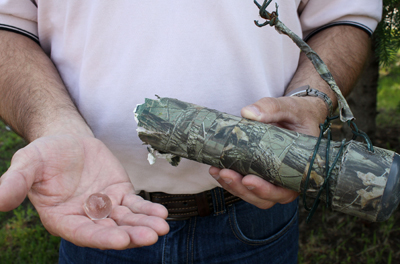 |
|

|
 |
TABLE of CONTENTS
 |
Winter never really ends at MnDOT |
By Sue Roe

The statewide snowfall average in 2014-15 was 39.4 inches compared to 75.6 inches in 2013-14. Photo by David Gonzalez |
The plow blades and sanders are off the trucks and the snow and ice are long gone, but many MnDOT employees are still knee-deep in winter. They’re compiling information on the costs of winter past, while others are making plans for the winter to come.
“We’re never totally out of the mindset of winter,” said Bob Vasek, maintenance operations engineer. “We’re working on the statewide snow and ice plan now to address labor, materials and equipment needs for next year. The plan is completed yearly and every district develops an appendix with strategies that apply to their local operations.”
Vasek manages contracts for snow and ice commodities such as salt, aggregates and deicers. Some materials, such as salt, are ordered early to ensure MnDOT gets the best prices available.
“Winter is never-ending,” he said.
When the legislative session is over, budgets are set up for the upcoming fiscal year.
“We incorporate changes made by the Legislature, which almost always have significant impacts on winter activities,” said Josh Knatterud-Hubinger, Budget and Forecasts Unit of the Office of Financial Management.
Rick Shomion, maintenance training coordinator, leads the annual SPOT, or Snow Plow Operators Training, which prepares new snowplow drivers to clear roads. He is working with districts to determine the number of employees who will attend the two-week session this fall.
“Knowing the number of attendees determines the amount of supplies to order, how many sessions to offer and the number of trucks and trainers we need,” Shomion said.
Some departments work on research projects to study ways to more effectively and efficiently perform winter operations.
“The research we do out of maintenance operations helps the front-line workers with ways to be safer and more efficient,” said Ryan Otte, who manages the maintenance operations research program.
For example, crews are testing alternative styles of patching that can withstand cold temperatures. The ability to place permanent patches during the winter is limited because of the type of materials available.
Crews are also testing the use of an anti-corrosion product that blocks road salts and moisture on the metals and electrical connections on plow trucks.
Other research includes live-stream images of traffic conditions from snowplows; a mobile surface condition sensor, which will help determine when to apply winter chemicals; and a data-driven road condition recovery time estimation system.
The Maintenance Office works year-round with other agencies, such as the Clear Roads Pooled Fund Research Program, to research common winter maintenance issues and develop training programs and manuals on management practices, winter maintenance strategies and best practices. The office also collaborates with districts, vendors and agencies to research different methods, materials and equipment for winter maintenance.
The districts paint and repair snow and ice equipment, order parts such as cutting edges and fill up salt sheds between winter seasons.
The Central Shop and Equipment Section works year round on acquisition of the trucks and equipment used for winter and summer operations. Some equipment is fabricated and installed by Central Shop staff.
“I can’t think of a time where we’re not doing something regarding winter,” said Wade Adams, District 7 and Central Office transportation program specialist. “There’s just not much down time.”
In conjunction with the Office of Finance, the Maintenance Office compiles the annual snow and ice season financial report, which highlights labor, materials and equipment costs. To see the 2014-15 report on iHub go to Snow and Ice Reports at A to Z.
2014-15 winter by the numbers:*
- Statewide snowfall average – 39.4 inches (75.6 inches in 2013-14)
- Official snowfall (MSP Airport) – 32.6 inches (69.9 inches in 2013-14)
- District with most snowfall – District 1 (45.1 inches)
- District with least snowfall - District 7 (33 inches)
- Salt usage – 173,888 tons
- Sand usage – 39,772 tons
- Brine usage – 2.2 million gallons
- Frequency of meeting bare lanes - 87 percent (target is 70 percent)
- Years MnDOT met or exceeded bare lanes target: 9 out of past 10 years
- Full cost of 2014-15 season - $86.1 million ($136.2 million in 2013-14)
- Statewide average costs per lane mile - $2,819 ($4,435 in 2013-14)
*Information from Office of Finance, the Business Intelligence Program and districts
|
|
 |
|

|
 |
TABLE of CONTENTS
 |
Hwy 5 project to replace deck on Mississippi River Bridge |
|
The Hwy 5 project video summarizes the construction project for the Hwy 5 Bridge over the Mississippi River between St. Paul and Ft. Snelling. Eric Rustad, project engineer, explains what is taking place on the bridge and the timelines for completion. Video produced by Rich Kemp |
|
 |
|

|
 |
TABLE of CONTENTS
 |
Future will be quieter for Minnesota rumble strips |
|
By Shannon Fiecke
Ken Johnson, state pavement marking engineer, has been fielding calls from across the country ever since researchers wrapped up a noise comparison study that found a rumble strip quieter than the one commonly used in states like Minnesota.

The current Minnesota rumble strip, left, and a sinusoidal rumble strip. Photo courtesy of Research Services |
The study, conducted in Polk County, compared Minnesota’s traditional rumble strip design – rectangular-shaped chunks ground out of the pavement – with a sinusoidal-style rumble strip used in Europe that features a continuous wave pattern.
Although further testing this summer and fall will refine the design, a few MnDOT districts are already planning to install the sinusoidal rumble strip with upcoming projects, due to the number of complaints they’ve received about the old design.
Although Minnesota’s rumble strip greatly enhances driver safety, it also produces unwanted noise that can be heard as far as 3,000 feet away. Fearing a legislative restriction because of push-back from rural homeowners, MnDOT was eager to find a more neighborly design.
Minnesota has more than 800 miles of centerline rumbles on the state highway system. When applied to the centerline, rumble strips can reduce crashes from vehicles crossing into the other lane by as much as 44 percent.
The sinusoidal rumble strip MnDOT studied was based off a 14-inch long wavelength design tested in 2013 by California (Caltrans hasn't switched to the new design). It provided good levels of internal vehicle noise, but with much less stray noise outside the vehicle.
In addition to more external noise, Minnesota’s current rumble strip standard design has a considerably stronger tone that can be heard further away.
“Minnesota’s has a really sharp peak,” said David Braslau, acoustical engineer and study author. “So while the absolute sound level of California’s sinusoidal rumble strip isn’t all that much lower, its perception is.”
MnDOT installs rumble strips with new pavement projects on most rural two-lane state roads, either along the centerline, the road edge or both. But MnDOT has granted exceptions for highway sections near homes and some districts have waited to install rumble strips until a quieter design is selected. In some locations, MnDOT has even filled rumble strips due to complaints.
Testing was performed using three different vehicles – a passenger car, pickup truck and semi-trailer truck – at three different speeds – 30, 45 and 60 miles per hour.
Researchers also noise-tested a sinusoidal rumble strip with a longer wave pattern that was previously studied in Pennsylvania. It produced less interior vehicle noise, however, and Pennsylvania is also now interested in MnDOT’s research.
The Polk County study was initiated by the Local Road Research Board, with participation from MnDOT.
As MnDOT prepares to adopt a final design later this year, variations of the sinusoidal design will be tested for motorcycles at the MnROAD facility in Albertville, and along a rural highway in Minnesota. A couple issues researchers must consider include pavement marking wear, and possible joint damage for rumble strips applied directly over the centerline.
While some people are already calling the sinusoidal rumble strip the “mumble strip,” Johnson isn’t ready to do that just yet.
“Once the final design is modified and proven, we may call it the Minnesota Mumble Strip,” he said. “But the nuisance noise really needs to be low before it deserves that name.”
This video, shot near Thief River Falls, Minn., shows a comparison between traditional rumble strip designs and the newer sinusoidal rumble strips. Video produced by Nick Busse |
|
 |
|

|
 |
TABLE of CONTENTS
 |
Suspicious object found in culvert prompts question: What would you do? |
By Beth Petrowske, District 1 public affairs coordinator
What would you do if you were on the job and came across something like this?

This device, wedged between stones, was found June 4 inside a 500-foot-long culvert in Duluth. Photo by Kevin Rohling |
- Walk up and get a closer look.
- Leave the area, secure a safe perimeter and immediately notify your supervisor or call the Minnesota Duty Officer.
- Decide it’s probably a geocache and open it to see what’s inside.
- Decide it’s a geocache, don’t tell anyone else and leave it undisturbed.
In the context of a quiz, the correct answer seems obvious: “Leave the area, secure a safe perimeter and immediately notify your supervisor or call the Minnesota Duty Officer.”
But, if you were working in the field or at a MnDOT facility and came across something like this, would you make the correct decision?
John Benson, District 1 transportation generalist supervisor, and Kevin Rohling, District 1 bridge engineer, discovered the device pictured above on the afternoon of Thursday, June 4, during a bridge safety inspection of the Kingsbury Creek culvert under Interstate 35 and Hwy 2 in Duluth.
“John was the first to see it and set the bar for proceeding cautiously,” said Rohling. “I think his fire fighter training told him it looked suspicious and as he showed it to me, his approach and demeanor suggested that we needed to be careful.”
Rohling thought the device could have been left by kids, but didn’t want to take any chances. He felt it needed to be evaluated by an expert so he took some photos and sent them to Steve Pecharich, District 1 safety administrator.
Pecharich then:
- Notified MnDOT leadership of the situation and discussed options for response. (A real improvised explosive device had been discovered in the Duluth area in March).
- Notified the District 1 public affairs coordinator so she was aware of the situation and would be prepared if media or citizens learned about the situation.
- Called the Minnesota Duty Officer in St. Paul at 1-800-422-0798. The Duty Officer put Pecharich in touch with the St. Paul Bomb Squad.
- Emailed photos of the device to the bomb squad. After seeing them, the bomb squad determined there was no immediate threat or hazard and decided they would investigate the next day.
- Contacted D1 Maintenance Operations and asked them to begin making arrangements for a detour in case one was necessary.
- Coordinated all communications between the bomb squad and D1 Operations staff.
Friday morning, June 5
The bomb squad assessed the situation and removed the device by cutting the wires that held it to the metal arch portion of the culvert and wrapped it in a tube-like blanket. They carried it out of the culvert on-foot because the terrain was too rough to send in a robot.
Members of the squad wore street clothes during the removal. Perry Collins, District 1 assistant district engineer for operations, asked them why they didn’t wear protective clothing. They told him that because the device was placed in a confined space—if it detonated—whatever gear they were wearing would not provide much protection.
The bomb squad couldn’t tell for certain whether the device was an IED based on its appearance so they took it to a safe location about 300 feet from the culvert and placed it on the ground. A gun, mounted on a tripod-like stand, was aimed at the device and fired by a remote detonator. To everyone’s relief, there was no explosion—it wasn’t an IED. Upon inspection, the device was identified as a geocache and inside it, was a marble.

The mysterious device turned out to be a piece of PVC pipe covered with camouflage duct tape. Inside was a marble. Photo by Beth Petrowske |
Pecharich then scheduled a debriefing to discuss what went right and what could be done better in the future.
“We thought that everything went well, but we felt we could have improved on our staff training so that employees know—without a doubt—what to do if they find something like this,” said Pecharich.
Pecharich is working on a fact sheet that will help employees know how to respond if they discover something that could be an IED. He is also planning to have more in-depth training at new employee orientations and annual maintenance meetings about geocaching awareness and IEDs.
|
 |
|

|
 |
TABLE of CONTENTS
 |
Enrollment opens June 29 for Leadership Development Program |

From left, Shawn Meade, Carol Hennekens and Amanda Klawiter facilitate the Leadership Development Program. Photo by Rich Kemp |
A knowledgeable, skilled and well-trained workforce is critical to MnDOT’s success. Employees’ motivation and willingness to improve competencies allow the agency to remain adaptable and productive, ultimately provide quality service to its customers, according to Carol Hennekens, program manager. Considering the benefits far outweigh the costs, improving competencies is an opportunity to embrace.
“We have been offering the Leadership Development Program for more than three years, and the momentum is just starting,” said Hennekens. “Employees are seeing the benefits of participating in the program and are using the program’s resources to assist them with their own development. Each year, we provide different learning opportunities and additional resources, so employees can participate year after year.”
Because MnDOT is dedicated to providing an environment for all employees to be successful at work, the Leadership Development Program continues to be offered. Open to all employees, the program is individually customized and flexible to meet participants’ development goals. It can be structured, informal, rigorous, ongoing and flexible all at the same time. This unique program requires participants to create their own development goals and set their own schedule to fit their busy work schedule.
“The program has been a great opportunity and the most positive experience I’ve participated in at MnDOT,” said Bret Anderson, District 3 employee, who is currently in the program. “It allowed me to network, learn about myself and expand my knowledge of how to positively and effectively address situations encountered within the workplace and personal life alike. I look forward to using the skills I attained and to further my career and learning within MnDOT and the Leadership Development Program.”
The 2015-16 Leadership Development Program will have two groups starting at different times. Group 5 will start Sept. 1, 2015, and Group 6 will start March 1, 2016. Employees can enroll in either group during the enrollment period, which starts June 29. A second enrollment period for Group 6 is scheduled for December 2015.
To learn more about the Leadership Development Program, and how to enroll, check out the LDP website at http://ihub.dot.state.mn.us/leadership/, or attend an optional Lync Information Session (see the dates below). An email to all employees will go out soon with more information on how to register to attend one of these sessions.
Leadership Development Program – Optional Lync Information Sessions
Tuesday, June 16 – 2:30 to 3 p.m.
Wednesday, June 17 – 8:30 to 9 a.m.
Tuesday, June 23 – 3 to 3:30 p.m.
Wednesday, June 24 – 10 to 10:30 a.m.
Wednesday, July 1 – 1 to 1:30 p.m.
For questions, contact Carol Hennekens, Shawn Meade or Amanda Klawiter. |
 |
|

|
|
| |
|



